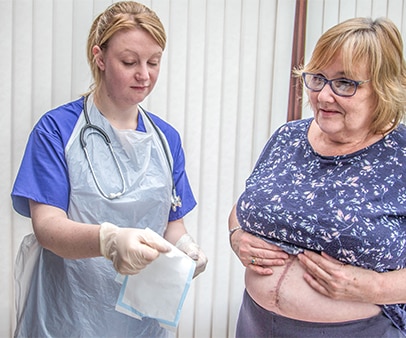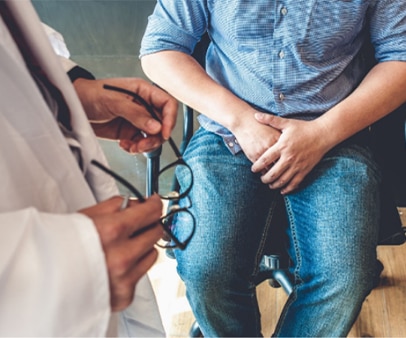About Umbilical Hernias
An abnormal bulge that can be seen or felt at the umbilicus (belly button), umbilical hernias occur when a portion of the intestine, lining of the abdomen, or fluid from the abdomen pushes through the muscle of the abdominal wall. Umbilical hernias most often occur in newborns and 90% will close naturally by the time the child turns 5 years old.1
Did you know: Unlike most hernias which develop in adolescence or adulthood, 20% of babies are born with umbilical hernias?1
Common Symptoms of Umbilical Hernias
Umbilical hernias may appear as a bulge or swelling near the belly button that becomes more noticeable when you or your baby cries, coughs, or strains.
Although umbilical hernias in children are usually painless, those that appear during adulthood may cause pain or abdominal discomfort.2 Contact your healthcare provider immediately if you or your child experiences severe symptoms/complications of an umbilical hernia including:
- Pain near the navel
- Vomiting
- Fever
- Constipation
- Full, round abdomen
- Tenderness, swelling, or discoloration of the hernia site
These may signify a serious condition called ‘strangulation’ where an obstruction of your intestines can cut off blood flow causing intestinal or bowel tissue to die, which can lead to emergency surgery.
Potential Causes of Umbilical Hernias in Children2
As the fetus develops during pregnancy, a small opening in the abdominal muscle allows the umbilical cord to pass through and connects the baby to mother. After birth and as the child grows, the opening in the abdominal muscle closes. However, when these muscles do not meet and grow together, a small opening (umbilical hernia) remains.
Potential Causes of Umbilical Hernias in Adults
While umbilical hernias in adults are fairly uncommon (only 2% of the adult population show occurrences),3 it is possible for an umbilical hernia to appear during adulthood. Contributing factors may include chronic health conditions that raise abdominal pressure, including:
- Carrying excessive belly fluid (ascites)
- Multiple pregnancies
- Chronic cough
- Repetitive vomiting
- Obesity
- Straining during urination, bowel movements, childbirth, weightlifting
- Prior abdominal surgery
Ways to Diagnose Umbilical Hernias
To identify whether you or your child has an umbilical hernia, your healthcare provider will likely begin with a physical examination. During the exam, they will observe and gently touch the area to determine whether the hernia is reducible (i.e., able to be pushed back into the abdominal cavity). Blood tests may be ordered to look for any signs of an infection. In adults, a barium X-ray, ultrasound, a computed tomography scan (CT scan) or magnetic resonance imaging (MRI) may be ordered to examine the intestine more closely.1
Treatments for Umbilical Hernias4
Most umbilical hernias in babies close by the time a child turns 5 years old. Your child’s doctor may even be able to push the bulge back in during a physical exam. For children, surgery is typically reserved for umbilical hernias that:
- Are painful
- Are larger than 1/4 to 3/4 of an inch (1-2 centimeters) in diameter and don’t decrease in size over the first 2 years
- Don’t disappear by age 5
- Become strangulated
Specific treatment for an umbilical hernia will be determined by your doctor and depends on many factors, including the severity of your symptoms, the size of your hernia, and your general health. For adults, surgery is typically recommended to avoid possible complications—especially if the umbilical hernia becomes painful or gets bigger.4 However, if your umbilical hernia is small-to-moderate in size, your doctor may recommend you ‘watch and wait’ where your condition will be monitored to see if symptoms progress.
Surgical Treatment
There are two primary surgical options for treating an umbilical hernia: open and minimally-invasive laparoscopic surgery. Surgery to repair an umbilical hernia is performed under general anesthesia.2 The appropriate type of surgery may depend on individual patient factors.
Open Surgery: As the traditional surgical method, an open surgical procedure involves making a large incision at the base of the belly button. The hernia bulge is returned to its correct position and a mesh is often placed to help strengthen and support the weakened area before closing up the incision.
Laparoscopic Surgery: A surgeon will use several small, key-hole sized incisions during laparoscopic surgery. Instruments, such as a camera, are then inserted through the incisions to perform the operation.
What Are the Next Steps to Treat an Umbilical Hernia?
If you or your child has symptoms of an umbilical hernia, contact a healthcare provider as soon as possible to have it diagnosed and/or treated.
The guidance provided in this article follows general rules that should be discussed with your doctor. TThis article is for informational and educational purposes only. It does not substitute for medical advice. If in doubt, always consult your doctor.
Related Articles
Join the HerniaInfo.com community! Get notified about our latest articles and updates on all things hernia as they become available.
References
- https://www.hopkinsmedicine.org/health/conditions-and-diseases/hernias/umbilical-hernia
- https://www.cincinnatichildrens.org/health/u/umbilical-hernia#:~:text=An%20umbilical%20hernia%20is%20an,muscle%20of%20the%20abdominal%20wall
- https://www.ncbi.nlm.nih.gov/books/NBK459312/#:~:text=The%20Incidence%20of%20Umbilical%20hernia,develop%20umbilical%20hernia%5B5%5D
- https://www.mayoclinic.org/diseases-conditions/umbilical-hernia/diagnosis-treatment/drc-20378689
This site is not intended as a substitute for professional medical care. Only your physician can diagnose and appropriately treat your symptoms. BD does not recommend the use of any particular physician or team of physicians. Please consult your healthcare provider for advice regarding who should be part of your hernia repair team.
BD-90442


